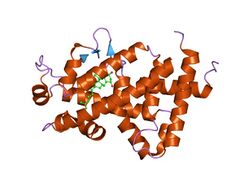Chemistry:Evolution of the vitamin D receptor
The evolution of the vitamin D receptor started millions of years ago, with earliest evidence of the receptor in existing organisms tracing back to the sea lamprey (Petromyzon marinus).[1][2] The vitamin D receptor is an example of a nuclear receptor, which binds vitamin D, and modulates the transcription of various target genes appropriately. Early in the history of life on Earth, nuclear receptors would have been selected for due to the strong pressure for organisms to respond to their environment. This eventually lead to the evolution of nuclear receptor families, such as the NR1H and NR1I families, capable of binding nutritional ligands and modulating transcription appropriately.[1] Each of these families host a variety of receptors, including the vitamin D receptor, but all are thought to have originated from one ancestral receptor. Through major gene duplications and variable selective pressures, the various receptors within these families evolved, each one accommodating cholesterol derivatives, such as oxysterols, bile acids, and vitamin D.[1]
Vitamin D receptor

A functional vitamin D receptor (VDR) can be found in almost all vertebrate animals.[3] Vitamin D acts as a potent steroid hormone to regulate the transcription of over 900 genes via interactions with the VDR.[4] Together with the retinoid X receptor (RXR), the VDR can regulate transcription via activation or repression of various target genes. The different genes that are subject to such transcriptional regulation are marked by distinct vitamin D receptor elements (VDRE), which are generally located in the 5′ upstream regions of a variety of vitamin D target genes.[5] Through transcriptional regulation, vitamin D plays an important role in various biological processes including growth, development, antioxidation, and homeostasis in vital tissues.[6]
Vitamin D hormone

Although the VDR is found across vertebrate animals, vitamin D metabolites can be traced to the earliest signs of life.[3] In organisms such as algae and plankton, the cholesterol derivative, 7-dehydrocholesterol, is actively converted to vitamin D3 (cholecalciferol) upon exposure to ultraviolet B (UVB) radiation. This photoconversion has occurred for millions of years and is thought to have originally acted as a form of protective sunscreen from harmful ultraviolet radiation (UV).[3] This would have been necessary as there was little to no protection from UV radiation due to an unestablished ozone layer. There are other proposed functions of vitamin D metabolites in these early eukaryotes, but no experimental evidence exists to confirm the true function.
However, sterol molecules, such as vitamin D metabolites, have the potential to act as strong nutritional signaling molecules. For instance, accumulation of cholecalciferol could potentially signal to early algae and plankton that they were under high exposure to UV radiation. In this case, it would be advantageous for these organisms to respond in various ways in order to avoid further UV damage. These organisms could respond by moving their physical position in the water-sinking deeper to depths UV radiation cannot penetrate- or genetically-by changing their transcriptional response in order to activate genes that would help defend against the UV rays. Whatever the response may be, this is thought to have created selective pressure, resulting in the evolution of transcription factors which respond to environmental cues and control gene regulation.[1] Through an adaptation process involving major gene duplications, the nuclear receptor (NR) family evolved, including the NR1H and NR1I subfamilies.[1]
Nuclear receptors
The NR1H and the NR1I subfamilies host major nuclear receptors, all of which are thought to have the same ancestor. The NR1H subfamily comprises the liver X receptor (LXR) α and β, as well as the farnesoid X receptor (FXR).[1] The NR1I subfamily hosts the VDR, pregnane X receptor (PXR) and constitutive androstane receptor (CAR).[1] These receptors are sensors for cholesterol derivatives, such as oxysterols, bile acids, and vitamin D.[1] Receptors in these subfamilies can be found across the tree of life, including in invertebrates like Caenorhabditis elegans (C. elegans), cartilaginous fish such as lamprey, and all other vertebrate organisms.[7]
One potential reason that may explain why early organisms eventually evolved a vitamin D receptor is due to the massive difference in calcium concentration between ocean water, fresh water, and land.[3] As organisms were transitioning out of the ocean and onto land, the difference in calcium concentration available to these organisms would have been stark, and this difference would require a way to tightly regulate calcium concentrations within the organisms.[8] As discussed above, nuclear receptors are effective ways to manage such a regulatory system, as they provide the ability to sense environmental/nutritional conditions and to generate the appropriate transcriptional response. In this case, it could have been that a parent receptor existed already, and adapted via gene duplication and mutation in order to gain the ability to regulate calcium levels appropriately. When considering the homology that exists between the ligand binding domains, as well as the phylogenetic relationship between these nuclear receptors, it is logical to assume that the original function of the parent receptor was to regulate metabolism.[1] Over time, these receptors could have mutated to accommodate various ligands, and to produce novel transcriptional responses.
Evidence for evolution

While much of the work into deciphering the origins of the VDR is speculative, experimental evidence does exist that strengthens our confidence in these proposed hypotheses. For example, the VDR has been identified across many different organisms, and in many of these organisms, the function of the receptor has been elucidated. One example of this is in the lamprey (Petromyzon marinus), an ancient vertebrate lacking a calcified skeleton and teeth. It seems unusual that the lamprey, an organism with no calcified skeleton, would be identified as to having a functional vitamin D receptor. However, evidence from this study suggested that the VDR may function in part, like pregnane X receptors and constitutive androstane receptors, to induce cytochrome P450 enzymes for xenobiotic detoxification.[2] Due to its evolutionary relationship to modern vertebrates, this insight allows us to speculate that the early function of this receptor was detoxification. This finding suggests that 150 million years before organisms left the ocean, the core proteins of vitamin D endocrinology, the VDR, and cytochrome P450 proteins, evolved in a softbody vertebrate without a calcified skeleton and teeth.[1]
In C. elegans, an invertebrate organism, three receptors belong to NR1J subfamily considered homologous to the VDR, DAF-12(NR1J1), NHR-8(NR1J2), and NHR-48(NR1J3). Of these receptors, NHR-8 is known to regulate cholesterol levels, is important for the host immune response, and is implicated in the detoxification system in the worm.[9] These are all known functions of the modern VDR that exists in vertebrates today, only lacking the ability to regulate calcium homeostasis.[10]
References
- ↑ 1.00 1.01 1.02 1.03 1.04 1.05 1.06 1.07 1.08 1.09 "Vitamin D and evolution: Pharmacologic implications". Biochemical Pharmacology 173: 113595. March 2020. doi:10.1016/j.bcp.2019.07.024. PMID 31377232. https://erepo.uef.fi/handle/123456789/8181.
- ↑ 2.0 2.1 "Cloning of a functional vitamin D receptor from the lamprey (Petromyzon marinus), an ancient vertebrate lacking a calcified skeleton and teeth". Endocrinology 144 (6): 2704–16. June 2003. doi:10.1210/en.2002-221101. PMID 12746335.
- ↑ 3.0 3.1 3.2 3.3 "Vitamin D: calcium and bone homeostasis during evolution". BoneKEy Reports 3: 480. January 2014. doi:10.1038/bonekey.2013.214. PMID 24466411.
- ↑ "Vitamin D hormone regulates serotonin synthesis. Part 1: relevance for autism". FASEB Journal 28 (6): 2398–413. June 2014. doi:10.1096/fj.13-246546. PMID 24558199.
- ↑ Vitamin D (2nd ed.). Amsterdam: Elsevier Academic Press. 2005. ISBN 978-0-12-252687-9. OCLC 162572206. https://www.worldcat.org/oclc/162572206.
- ↑ Vitamin D Hormone. Gerald Litwack (1st ed.). Cambridge, MA. 2016. ISBN 978-0-12-805240-2. OCLC 936379408.
- ↑ "Functional evolution of the vitamin D and pregnane X receptors". BMC Evolutionary Biology 7 (1): 222. November 2007. doi:10.1186/1471-2148-7-222. PMID 17997857.
- ↑ "Vitamin D: evolutionary, physiological and health perspectives". Current Drug Targets 12 (1): 4–18. January 2011. doi:10.2174/138945011793591635. PMID 20795941.
- ↑ "The NHR-8 nuclear receptor regulates cholesterol and bile acid homeostasis in C. elegans". Cell Metabolism 18 (2): 212–24. August 2013. doi:10.1016/j.cmet.2013.07.007. PMID 23931753.
- ↑ "The function of vitamin D receptor in vitamin D action". Journal of Biochemistry 127 (5): 717–22. May 2000. doi:10.1093/oxfordjournals.jbchem.a022662. PMID 10788778.
